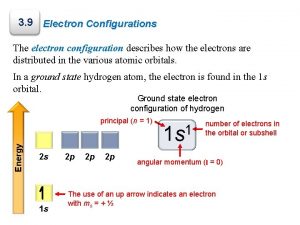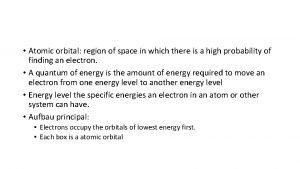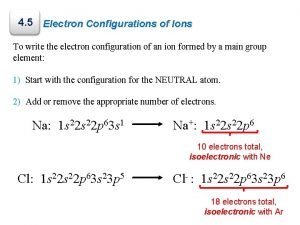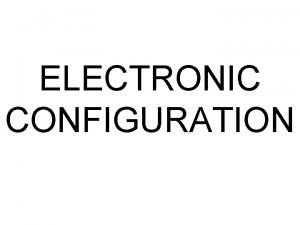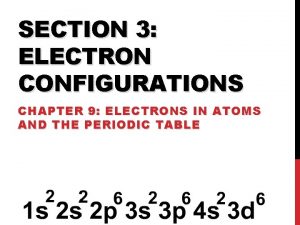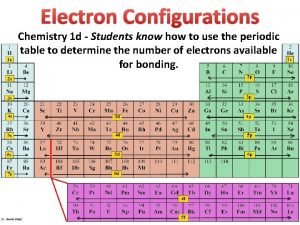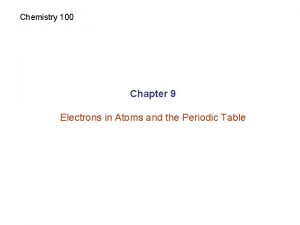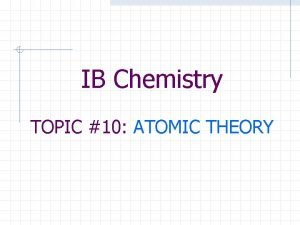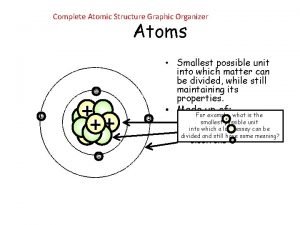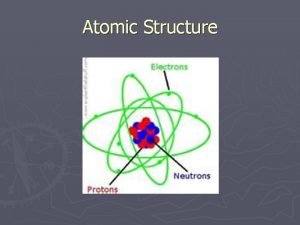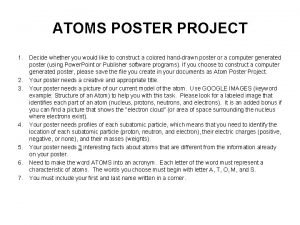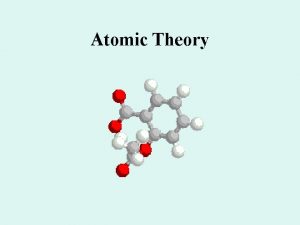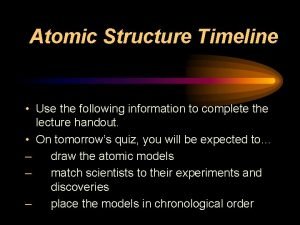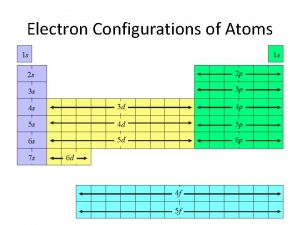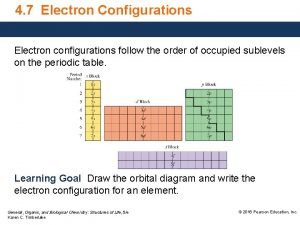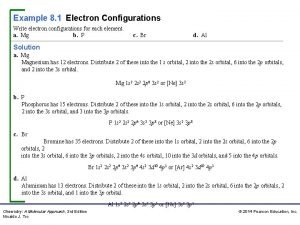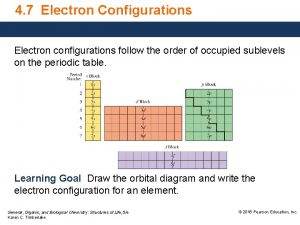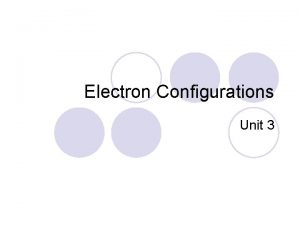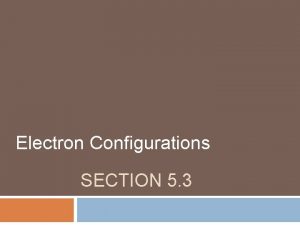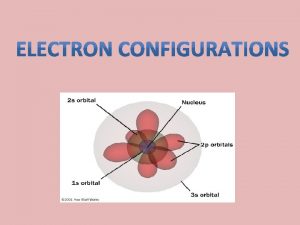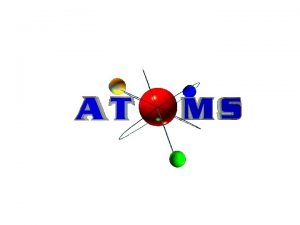Ch 4 Atomic Structure Electron Configurations Electron Configurations



































- Slides: 35

Ch. 4 Atomic Structure Electron Configurations

Electron Configurations Ø the arrangement of electrons in an atom Ø each type of atom has a unique electron configuration Ø electrons tend to assume positions that create the lowest possible energy for atom Ø ground state electron configuration- lowest energy arrangement of electrons

Rules for Arrangements Ø Aufbau Principle- an electron occupies the lowest-energy orbital that can receive it Ø Beginning in the 3 rd energy level, the energies of the sublevels in different energy levels begin to overlap

Rules for Arrangements Ø Pauli Exclusion Principle- no two electrons in the same atom can have the same set of 4 quantum numbers Ø Hund’s Rule- orbitals of equal energy are each occupied by one electron before any orbital is occupied by a second Ø all unpaired electrons must have the same spin

Rules for Arrangements

Writing Configurations Ø Orbital Notation: l l l an orbital is written as a line each orbital has a name written below it electrons are drawn as arrows (up and down) Ø Electron Configuration Notation l number of electrons in sublevel is added as a superscript

Order for Filling Sublevels

Writing Configurations Start by finding the number of electrons in the atom Ø Identify the sublevel that the last electron added is in by looking at the location in periodic table Ø Draw out lines for each orbital beginning with 1 s and ending with the sublevel identified Ø Add arrows individually to the orbitals until all electrons have been drawn Ø

Silicon number of electrons: 14 Ø last electron is in sublevel: 3 p Ø 1 s 2 s 2 p 3 s 3 p ØValence Electrons- the electrons in the outermost energy level

Chlorine number of electrons: 17 Ø last electron is in sublevel: 3 p Ø 1 s 2 s 2 p 3 s 3 p

Sodium number of electrons: 11 Ø last electron is in sublevel: 3 s Ø 1 s 2 s 1 s 2 2 p 6 3 s 1 2 p 3 s

Calcium number of electrons: 20 Ø last electron is in sublevel: 4 s Ø 1 s 2 s 3 p 2 p 4 s 1 s 2 2 p 6 3 s 2 3 p 6 4 s 2 3 s

Bromine number of electrons: 35 Ø last electron is in sublevel: 4 p Ø 1 s 4 s 2 s 2 p 3 s 3 d 1 s 2 2 p 6 3 s 2 3 p 6 4 s 2 3 d 10 4 p 5 3 p 4 p

Argon number of electrons: 18 Ø last electron is in sublevel: 3 p Ø 1 s 2 s 2 p 1 s 2 2 p 6 3 s 2 3 p 6 3 s 3 p

Noble Gas Notation short hand for larger atoms Ø configuration for the last noble gas is abbreviated by the noble gas’s symbol in brackets Ø

Ch. 5: Atomic Structure Periodic Table and Periodic Trends

Periodic Table Ø Russian, Dmitri Mendeleev Ø when he arranged them by atomic mass, he found similar properties at certain intervals Ø published the first periodic table in 1869 Ø left empty spaces where he predicted undiscovered elements should be Ø confirmed his predictions and persuaded other chemists

Periodic Table Ø In 1911, Henry Moseley (English) found that the pattern worked best if arranged by number of protons Ø Our current periodic tables use this method or arrangement

Atomic Radii Ø Defined by the edge of its orbital but since the edges are fuzzy, difficult to determine Ø Atomic Radii – half the distance between the nuclei of identical atoms that are bonded together


Atomic/Ionic Radii

Which is bigger? Ø Na or Rb? Ø Na or S? Ø S or Te?

Ionization Energy Ø An electron can be removed from an atom if enough energy is used Ø Ionization energy – the energy required to remove one electron from a gaseous neutral atom A + energy A+ + e-

Ionization Energy

Ionization Energy

Which has higher IE? Ø Li or F? Ø Ca or P? Ø Ba or Li?

Electron Affinity – the energy change when an electron is added to a gaseous neutral atom l exothermic (-) A + e- A- + energy


Electron Affinity

Which has higher EA? Ø Ge or C? Ø In or I? Ø Mg or F?

Electronegativity Ø applies when an atom is in a compound NOT alone Ø Electronegativity – measure of how strongly an atom attracts electrons when it is in a compound Ø Fluorine (the most electronegative element) is assigned a 4. 0 and then all the others were determined by comparison



Electronegativity

Which has higher electronegativity? Ø Sr or Be? Ø P or O? Ø Si or Cl?
 The most stable arrangement of electrons is
The most stable arrangement of electrons is Electron configurations and periodicity
Electron configurations and periodicity Stable electron configurations are likely to contain
Stable electron configurations are likely to contain Chapter 5 electrons in atoms
Chapter 5 electrons in atoms An orbital is a region of space in an atom where there is
An orbital is a region of space in an atom where there is Dot
Dot Stable electron configurations
Stable electron configurations Is atomic mass and relative atomic mass the same
Is atomic mass and relative atomic mass the same Period trends
Period trends Atomic radius on periodic table
Atomic radius on periodic table Atomic weight of oxygen
Atomic weight of oxygen Difference between atomic number and atomic mass
Difference between atomic number and atomic mass Atomic number vs atomic radius
Atomic number vs atomic radius Rigid pavement and flexible pavement
Rigid pavement and flexible pavement Ac load line analysis of transistor
Ac load line analysis of transistor What does electron configuration mean
What does electron configuration mean Copper subshell configuration
Copper subshell configuration S electrons
S electrons Electrons configurations
Electrons configurations Bjt regions
Bjt regions Ceedar innovation configurations
Ceedar innovation configurations Atomic structure and properties ap chemistry
Atomic structure and properties ap chemistry Atom subatomic particles
Atom subatomic particles Atomic universe theory
Atomic universe theory Rectification formula
Rectification formula What is calcium ionization energy
What is calcium ionization energy Ib chemistry atomic structure
Ib chemistry atomic structure Complete atom
Complete atom Atomic model and theory timeline
Atomic model and theory timeline Z atomic symbol
Z atomic symbol Tungsten atomic structure
Tungsten atomic structure What scientist discovered the electron
What scientist discovered the electron Atomic structure poster project
Atomic structure poster project Dalton thomson rutherford bohr timeline
Dalton thomson rutherford bohr timeline Atomic model schrodinger
Atomic model schrodinger Ap chemistry chapter 7
Ap chemistry chapter 7
